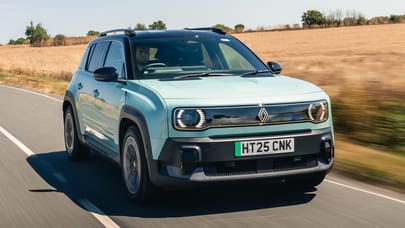
James May on street design
I know you’ve all been waiting. So here, then, reproduced entirely without permission, is some official blurb concerning the Government’s Manual For Streets, which appears to be some sort of initiative aimed at improving the design of our, urm, streets. Ready? Comfortable? Here we go.
The purpose of the Manual For Streets is to consolidate the necessary components for effective street design into a single integrated source of information and guidance that will facilitate professional communication and understanding.
There’s more!
The Manual will recognise the full range of design criteria necessary for the delivery of multi-functional streets and ensure that practitioners have the most up to date information available on the considerations relevant to those criteria, including quantitative thresholds where appropriate.
Now, is it just me, or is this bollocks? Having already suffered the words ‘facilitate’ and ‘delivery’, I decided I’d rather kill myself than read any more from the Manual For Streets. But then I realised there hadn’t been a ‘solution’ yet, so I decided not to kill myself and make an effort instead. And I discovered some disturbing things about the quest to make streets “social places, not just traffic spaces”.
For a start, I’m always suspicious of any attempt by the authorities to tell me how to enjoy myself. It’s all a bit strength-through-joy for my liking. It’s a small step from here to morning exercise in the park and community singing, you mark my words.
But I do agree with the basic premise that streets should be social places. In fact, the street where I live already is one. People live on it, run in and out of each others’ houses to borrow a cup of sugar, grow plants, talk rubbish, and moan about the bin men. We cook meals for each other, help each other with small DIY tasks and the subsequent rush to hospital, recommend builders and ask each other politely to turn the radio down. All this happens on my street. We even drive up and down it occasionally, although if other people drive up and down it too fast, we go out and shout at them. Multi-functional? We’re already there, although we haven’t yet used it as a landing strip.
How could this be improved? Well, apparently, speed humps could be removed – hoorah! – in favour of a doctrine of ‘shared space’. But hang on. Surely they’re not suggesting that there should be no delineation between the bit generally occupied by the cars and the bit that people walk on? My own experience of ignoring this well-established divide – when crossing the road, for example – suggests that this is a good way to get run over.
But I’m afraid that’s exactly what they’re suggesting. In the future, the road and the pavement will be on the same level, and trees will be planted at the edge of the road bit to “slow cars down”. I don’t think this will work. I was going to ring and ask Marc Bolan, but then I remembered that he died some time ago when his car hit a tree at the side of the road.
Top Gear
Newsletter
Thank you for subscribing to our newsletter. Look out for your regular round-up of news, reviews and offers in your inbox.
Get all the latest news, reviews and exclusives, direct to your inbox.
The authors of the Manual have been inspired by some residential areas in places like Holland, where the street is essentially a children’s playground and cars are slowed to walking pace and, at times, even excluded completely. This won’t work in Britain, though, because our children won’t play in the street. They’re all too fat, apparently, from spending too long slumped on the sofa watching Lazytown.
Elsewhere, the Manual For Streets suggests the construction of something called ‘pocket parks’ – small grassy areas near roads to encourage socialising. Again, I’m not convinced. Roads tend to be noisy, and unless you’re one of those mad French people who sits in a camping chair on the verge and watches cars all day, I don’t think roadsides are very sociable places. There’s a good reason why a mews house in London’s West End is worth £4 million and one next to the A4 is generally boarded up.
More to the point, there’s something a bit like a pocket park around the corner from my house; an area with benches and a cluster of trees. It is not used for socialising. It is used by tramps drinking Special Brew. We’re all socialising in the pub.
Admittedly, a lot of the thinking in the Manual For Streets is aimed at new streets; the streets that will need to be built around the hundreds of thousands of new houses that are needed to house all those people who are currently living in boxes. Or Latvia. But there is a perfectly good model for the successful development of new streets already in place in Britain – old streets. My own street was here for several hundred years before the car was invented, but seems to be able to accommodate it pretty well. The cars go down the bit in the middle, the people go along the bits at each side, and the bin lorry reverses into my wall. Simple.
Some of the thinking in the Manual just doesn’t add up. One-way streets, for example, are out of favour because, apparently, they “encourage speeding, prolonging journey times”. Exactly how going faster makes a journey take longer is not clear, but I’d be very interested to know, not least because it would render the work of Isaac Newton useless.
But here’s where it turns sinister. From now on, T-junctions will be deliberately designed with sharp corners, so that the approach to them will be blind. This will slow cars down.
I’m reminded of a project called something like ‘Towns in Bloom’ that ran when I first started driving. It encouraged, among other things, the planting of beds of flowers in the central reservations of dual carriageways, especially on the approach to a roundabout. This looked great, but the roundabout was always hidden behind a wall of chlamydias. So you could slow right down and have a look first, or carry on at normal speed and hope to jink around circulating traffic at the last moment. The choice was congestion or death.
And now we have a similar plan to make junctions dangerous in the interests of safety. The Government will get you on a bicycle yet. Or kill you in the attempt.
Trending this week
- Car Review
Honda Civic eHEV








